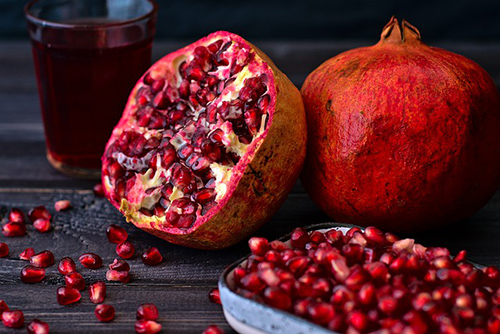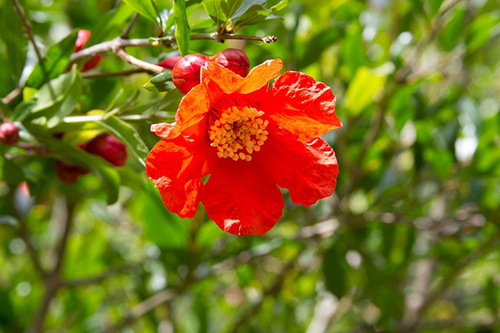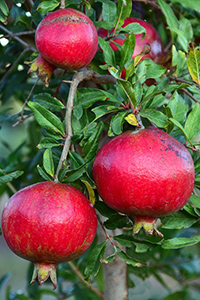Contents
The remains of the pomegranate tree have been found in Egyptian tombs that are over 4000 years old. Israelites appreciated this fruit, too. Greeks regarded pomegranates as the symbol of love and fertility. The pomegranate tree was dedicated to Aphrodite since its fruit was alleged to be an aphrodisiac.
The great Greek physician, pharmacologist, botanist, and author Pedanius Dioscorides, in the 1st century A.D., recommended the root of the pomegranate tree to “expel wide worms out of the belly.” Indeed, he was talking about taeniae. However, this plant was not used again with these goals until 1800 years after Dioscorides.
The pomegranate tree is a beautiful tree that has spread worldwide. Phoenicians brought it from western Asia to the Mediterranean area, and Romans, first, then Arabs, spread it all over southern European countries. Spaniards introduced it to America, where it spread all over the continent.

Pomegranate Tree Scientific Facts
- French: Granadier.
- Spanish:L Granado.
- Environment: Native to Persia and cultivated in Mediterranean countries and America, from California to Argentina and Chile. Some trees grow wild whenever birds defecate seeds after eating the fruits.
- Description: This tree of the Punicaceae family grows up to 4 m high. Its flowers are beautiful and unique, bright red, with an opened calyx. The fruit is a pomegranate.
- Parts of the plant used medicinally: The tree bark (especially its root), the flowers, and the fruits (pomegranate).
Healing Properties and Warning
The root bark and the lesser proportion of the trunk and branches bark contain several alkaloids, the most important being pelletierine. It also contains tannin, glycosides with astringent properties, and bromide. Its principal property is vermifuge: it helps to expel parasitic worms in the human intestine and is especially effective for taeniae.

The bark of the pomegranate tree, and especially that of its root, owes its properties to the alkaloids it contains. However, when these active components are administered isolated, they have toxic effects on the body, similar to those caused by nicotine or curare: muscular shivers and paralysis. These effects may also occur on the worms, allowing their expulsion through the anus.
However, when mixed with tannin and the other substances that form pomegranate tree bark, these alkaloids are well tolerated and practically lack any toxic effect on our bodies. The same happens with many other plants; therefore, it is better to administer the whole plant and not only extracts of the most active substances whenever possible. Plants’ healing action is due to the wise combination of their components, not only to isolated active components.
The fruit rind and inner walls also have vermifuge properties, though they are milder than the root or trunk bark. Sometimes, a person who eats a pomegranate expels an intestinal worm days later without the intention of doing so.

The FLOWERS of the tree and the fruit rind have astringent and mildly diuretic properties. They are recommended for:
- Diarrhea, gastroenteritis, and colitis were taken as an infusion.
- Inflammation of the gums (gingivitis) and the tissues fixing teeth to the jawbone (periodontitis or periodontist). The infusion is applied in mouth rinsings and can help improve loose teeth.
- Pharyngitis and tonsilitis are applied in gargles.
- Leukorrhea (white vaginal flow), applied in vaginal irrigations.

WARNING! The root bark of the pomegranate tree must never be administered to weak or nervous people, children on a milk diet, and pregnant women. Never exceed the recommended doses.
How to use The Pomegranate Tree
- Cold extract 60-90 g of root-dried bark in half a liter of water. Steep for 24 hours. Then boil over low heat until the liquid reduces by half. Drink for two or three days in the morning on an empty stomach. It can be sweetened with honey or flavored with peppermint essence. For children, put only 20-30 g of bark. A laxative infusion should be drunk a couple of hours after each intake.
- Infusion of flowers, with 20-30 g per liter of water. A pomegranate rind can be added per liter. Take a spoonful every hour until diarrhea stops.
- Mouth rinses and gargles, with the infusion of flowers with bark used internally.
- Vaginal cleansing or irrigations with the infusion mentioned above.
DISCLAIMER: All content on this website is presented solely for educational and informational objectives. Do not rely on the information provided as a replacement for advice, diagnosis, or treatment from a qualified medical expert. If you are pregnant, nursing, or have any preexisting medical concerns, talk to your doctor before using any herbal or natural medicines.
REFERENCES
- George D. Pamplona-Roger, M.D. “Encyclopedia of Medicinal Plants.” George D. Pamplona-Roger, M.D. Encyclopedia of Medicinal Plants. Ed. Francesc X. Gelabert. vols. 2 San Fernando de Henares: Editorial Safeliz, 2000. 523, 524. Print.
- Healthline: https://www.healthline.com/nutrition/12-proven-benefits-of-pomegranate
- WebMD: https://www.webmd.com/diet/health-benefits-pomegranates
